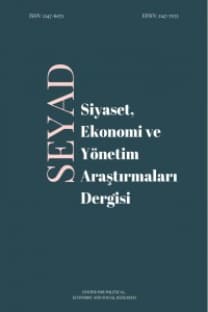Türkiye’de Kayıtdışı Ekonomi: Zaman Serisi ve Panel Veri MIMIC Tahminleri
Kayıtdışı ekonomi, MIMIC tahmin yöntemi, vergi yükü, devlet düzenlemeleri
Shadow Economy in Turkey: Time Series and Panel Data MIMIC Estimations
Shadow economy, MIMIC estimation method, tax burden, government regulation,
___
- Aigner, D., Schneider, F., and G., Damayanti (1988), “Me and my Shadow: Estimating the Size of the US Hidden Economy from Time Series Data”, In: Dynamic econometric modelling, ed. by W.A. Barnett and E.R. Berndt and H. White, pp. 224–243, Cambridge (Mass.): Cambridge University Press.
- Bollen, Kenneth A. (1989), Structural Equations with Latent Variables, New York: Wiley, 1989.
- Cagan, Phillip (1958), “ The Demand for Currency Relative to Total Money Supply”, Journal of Political Economy, 66, 303-328.
- Elgin, Ceyhun (2011), “Vergiler ve Kayıtdışı Ekonomi: Bir Değerlendirme Ve Türkiye Örneği”, http://www.econ.boun.edu.tr/public_html/RePEc/pdf/201105.pdf
- Del'Anno, R. (2003), “Estimating the Shadow Economy in Italy: a Structural Equation Approach”, School of Economics and Management, University of Aarhus, Economics Working Papers 2003-7. http://ideas.repec.org/p/aah/aarhec/2003-7.html
- Ducan, O.D. (1975), Intoduction to Structural Equation Models. New York: Academic.
- Feige, E. L. (1989), “The Meaning and Measurement of the Underground Economy”, Feige (ed.), the Underground Economies, Tax Evasion and Information Distortion. Cambridge: Cambridge University Press.
- Feige, E. L. (1989), “The Underground Economies, Tax Evasion and Information Distortion”, Cambridge University Press.
- Frey, Bruno S. and Hannelore Weck-Hanneman (1984), “The Hidden Economy as an ‘unobserved’ Variable.” European Economic Review, 26(1-2), pp. 33-53.
- Frey, Bruno S. And Werner Pommerehne (1984), The Hidden Economy: State and prospect for measurement”, Review of Income and Wealth, 30/1, pp. 1-23.
- Giles, David, E.A. (1999), “Modelling the hidden economy and the tax-gap in New Zealand, Empirical Economics, 24/4, pp. 621-640.
- Gutmann, P. M. (1977), “The Subterranean Economy”, Financial Analysts Journal, v. 34, 24-27.
- Jöreskog, K. and D. Sörbom (1993), LISREL 8: Structural Equation Modeling with the SIMPLIS Command Language, SSI Scientific Software International, Chicago.
- Jöreskog, K. and D. Sörbom (1996), “LISREL 8: User’s Reference Guide” SSI Scientific Software International, Chicago.
- Koyuncu, Cuneyt and Gautam Bhattacharyya (2007), “Predicting Corrupt Practices in the Public Sector for 23 OECD Countries”, Applied Econometric Letters and International Development, Vol. 7-1, pp. 15-36.
- Loayza, N.V. (1996), “The economics of the informal sector: a simple model and some empirical evidence from Latin America”, CarnegieRochester Conference Series on Public Policy, 45, pp.. 129-162.
- Mcgee, R. and E. L. Feige (1989) “Policy Illusion, Macroeconomic Instability, and the Unrecorded Economy” in: the Underground Economies, Tax Evasion and Information Distortion. Cambridge: Cambridge University Press.
- Prokhorov, Artem B. (2001), “The World Unobserved Economy: Definition, Measurement, and Optimality Considerations”, Central Michigan University.
- Rose-Ackermann, Susan (1999), “Corruption and Government: Causes, Consequences, and Reform” Cambridge University Press.
- Savaşan, Fatih (2009), The Hidden Economy, Estimation, the Link with Corruption and Dynamic Effects, VDM (Verlag Dr Müller) Publishing, 2009.
- Savaşan, Fatih (2002), Essays on the Hidden Economy, Ph.D Dissertation, the University of Kansas.
- Savasan, Fatih (2003) “Modeling the Underground Economy in Turkey: Randomized Response and MIMIC Models”. the Journal of Economics, v. XXIX, n.1, 49-76.
- Savasan, Fatih and Mehmet Emin Altundemir (2007), “Corruption and Hidden Economy: Letting the Fingerprints Tell the Story”, European Journal of Economics, Finance and Administrative Sciences, Issue 7, pp. 114-130.
- Savasan, Fatih and Friedrich Schneider, “What Determines Informal Hiring? Evidence from the Turkish Textile Sector”, the Middle East Business and Economic Review, Vol. 18, No. 2, 14-32 2006 .
- Schneider, Friedrich and Fatih Savasan (2007), “DYMIMIC Estimates of the Size of the Shadow Economies of Turkey and of Her Neighbouring Countries”, International Research Journal of Finance and Economics, Issue 9 (May), pp. 126-143.
- Schneider, Friedrich (2011), Size and Development of the Shadow Economy of 31 European and 5 other OECD Countries from 2003 to 2012: Some New Facts”, http://www.econ.jku.at/members/Schneider/files/publications/2012 /ShadEcEurope31.pdf Erişim: Ocak 2013)
- Schneider, Friedrich and Dominik Enste (2002), “Hiding in the Shadows: The Growth of the Underground Economy”, Economics Issues, No. 30 http://www.imf.org/external/pubs/ft/issues/issues30/ [Erişim: 30 Nisan 2016]
- Schneider, Friedrich and Robert Klinglmair (2004), Shadow Economies around the World: What Do We Know?”, CESIFO Working Paper, No. 1167.
- Tanzi, Vito (1999). “Uses and Abuses of Estimates of the Underground Economy”. The Economic Journal. 109, F338-347.
- ISSN: 2147-6071
- Yayın Aralığı: Yılda 2 Sayı
- Başlangıç: 2014
- Yayıncı: Politik Ekonomik ve Sosyal Araştırmalar Merkezi
Zirai İşletmelere Sağlanan Ipard Desteklerinin Muhasebeleştirilmesi
Ahmet BÜYÜKŞALVARCI, Ali GÜÇLÜ
Reorder Point and Replenishment Point of Dynamic Inventory Model under Shortages
Pazar Şartlarında Maliyet-Kapasite-Fiyatlandırma ve Kar İlişkisinin Simülasyonu
Türkiye’deki Ekonomik Büyüme ve İşsizlik İlişkisinin Analizi: Yeni Bir Eşbütünleşme Testi
Stokastik Sınır Analizi: İstanbul Sanayi Odası’na Kayıtlı Firmalara Yönelik Bir Uygulama
Türkiye’de Kayıtdışı Ekonomi: Zaman Serisi ve Panel Veri MIMIC Tahminleri
Fatih SAVAŞAN, Fatih YARDIMCIOĞLU, İbrahim DEMİR
Türkiye’de Mali Sürdürülebilirliğin Yapısal Değişimler Çerçevesinde Analizi 2002-2015
Osmanlı Hâkimiyetinde Aynoroz Yarımdası’ndaki Kilise ve Manastırlar
The Effects of Quality Management System on Patient Safety Culture in Hospitals
